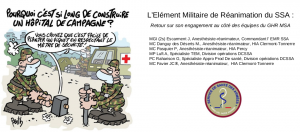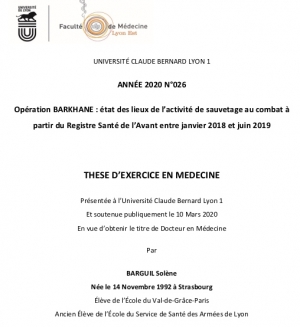24/04/2021
EMR SSA: Son bilan
16/04/2021
RSI: Transfusez avant si le blessé saigne +++
Rapid Sequence Induction Strategies Among Critically Injured U.S. Military During the Afghanistan and Iraq Conflicts
Emerling Alec D et Al. Mil Med. 2021 Jan 25;186(Suppl 1):316-323. doi: 10.1093/milmed/usaa356.
--------------------------------------------
Pour une meilleure stabilité hémodynamique des blessés graves, peu importe l'agent si l est employé à la bonne dose ET SURTOUT transfusez avant l'induction si votre blessé saigne/a saigné.
--------------------------------------------
Abstract
Introduction: Rapid sequence intubation of patients experiencing traumatic hemorrhage represents a precarious phase of care, which can be marked by hemodynamic instability and pulseless arrest. Military combat trauma guidelines recommend reduced induction dose and early blood product resuscitation. Few studies have evaluated the role of induction dose and preintubation transfusion on hemodynamic outcomes. We compared rates of postintubation systolic blood pressure (SBP) of < 70 mm Hg, > 30% drop in SBP, pulseless arrest, and mortality at 24 hours and 30 days among patients who did and did not receive blood products before intubation and then examined if induction agent and dose influenced the same outcomes.
Materials and methods:
A retrospective analysis was performed of battle-injured personnel presenting to surgical care facilities in Iraq and Afghanistan between 2004 and 2018. Those who received blood transfusions, underwent intubation, and had an Injury Severity Score of ≥15 were included. Intubation for primary head, facial, or neck injury, burns, operative room intubations, or those with cardiopulmonary resuscitation in progress were excluded. Multivariable logistic regression was performed with unadjusted and adjusted odds ratios for the five study outcomes among patients who did and did not receive preintubation blood products. The same analysis was performed for patients who received full or excessive versus partial induction agent dose.
Results:
A total of 153 patients had a mean age of 24.9 (SD 4.5), Injury Severity Score 29.7 (SD 11.2), heart rate 122.8 (SD 24), SBP 108.2 (SD 26.6). Eighty-one (53%) patients received preintubation blood products and had similar characteristics to those who did not receive transfusions. Adjusted multivariate analysis found odds ratios as follows: 30% SBP decrease 9.4 (95% CI 2.3-38.0), SBP < 70 13.0 (95% CI 3.3-51.6), pulseless arrest 18.5 (95% CI 1.2-279.3), 24-hour mortality 3.8 (95% CI 0.7-21.5), and 30-day mortality 1.3 (0.4-4.7). In analysis of induction agent choice and comparison of induction agent dose, no statistically significant benefit was seen.
Conclusion:
Within the context of this historical cohort, the early use of blood products conferred a statistically significant benefit in reducing postintubation hypotension and pulseless arrest among combat trauma victims exposed to traumatic hemorrhage. Induction agent choice and dose did not significantly influence the hemodynamic or mortality outcomes.
| Tags : intubation
12/04/2021
KIA pour les UK en Afghanistan
Killed in action (KIA): an analysis of military personnel who died of their injuries before reaching a definitive medical treatment facility in Afghanistan (2004-2014)
Introduction: The majority of combat deaths occur before arrival at a medical treatment facility but no previous studies have comprehensively examined this phase of care.
Methods: The UK Joint Theatre Trauma Registry was used to identify all UK military personnel who died in Afghanistan (2004-2014). These data were linked to non-medical tactical and operational records to provide an accurate timeline of events. Cause of death was determined from records taken at postmortem review. The primary objective was to report time between injury and death in those killed in action (KIA); secondary objectives included: reporting mortality at key North Atlantic Treaty Organisation timelines (0, 10, 60, 120 min), comparison of temporal lethality for different anatomical injuries and analysing trends in the case fatality rate (CFR).
Results: 2413 UK personnel were injured in Afghanistan from 2004 to 2014; 448 died, with a CFR of 18.6%. 390 (87.1%) of these died prehospital (n=348 KIA, n=42 killed non-enemy action). Complete data were available for n=303 (87.1%) KIA: median Injury Severity Score 75.0 (IQR 55.5-75.0). The predominant mechanisms were improvised explosive device (n=166, 54.8%) and gunshot wound (n=96, 31.7%).In the KIA cohort, the median time to death was 0.0 (IQR 0.0-21.8) min; 173 (57.1%) died immediately (0 min). At 10, 60 and 120 min post injury, 205 (67.7%), 277 (91.4%) and 300 (99.0%) casualties were dead, respectively.

Whole body primary injury had the fastest mortality. Overall prehospital CFR improved throughout the period while in-hospital CFR remained constant.
Conclusion: Over two-thirds of KIA deaths occurred within 10 min of injury. Improvement in the CFR in Afghanistan was predominantly in the prehospital phase.
10/04/2021
Ketamine: Le point US
Ketamine Use in Operation Enduring Freedom
Leslie E. et al. Mil Med . 2021 Apr 7;usab117. doi: 10.1093/milmed/usab117
------------------------------------
La Kétamine fait partie maintenant de l'arsenal thérapeutique utilisé par les US. Dans la discussion l'article évoque une probable sous déclaration d'emploi lié à un système de recueil des données encore à nparfaire au niveau des role 1
------------------------------------
Ketamine is a dissociative anesthetic increasingly used in the prehospital and battlefield environment. As an analgesic, it has been shown to have comparable effects to opioids. In 2012, the Defense Health Board advised the Joint Trauma System to update the Tactical Combat Casualty Care Guidelines to include ketamine as an acceptable first line agent for pain control on the battlefield. The goal of this study was to investigate trends in the use of ketamine during Operation Enduring Freedom (OEF) and Operation Freedom’s Sentinel (OFS) during the years 2011-2016.
A retrospective review of Department of Defense Trauma Registry (DoDTR) data was performed for all patients receiving ketamine during OEF/OFS in 2011-2016. Prevalence of ketamine use, absolute use, mechanism of injury, demographics, injury severity score, provider type, and co-administration rates of various medications and blood products were evaluated.
Total number of administrations during the study period was 866. Ketamine administration during OEF/OFS increased during the years 2011-2013 (28 patient administrations in 2011, 264 administrations in 2012, and 389 administrations in 2013). A decline in absolute use was noted from 2014 to 2016 (98 administrations in 2014, 41 administrations in 2015, and 46 administrations in 2016). The frequency of battlefield ketamine use increased from 0.4% to 11.3% for combat injuries sustained in OEF/OFS from 2011 to 2016. Explosives (51%) and penetrating trauma (39%) were the most common pattern of injury in which ketamine was administered. Ketamine was co-administered with fentanyl (34.4%), morphine (26.2%), midazolam (23.1%), tranexamic acid (12.3%), plasma (10.3%), and packed red blood cells (18.5%).
This study demonstrates increasing use of ketamine by the U.S. Military on the battlefield and effectiveness of clinical practice guidelines in influencing practice patterns.
06/04/2021
Barkhane: Analyse du RSA
Inexpérimenté mais sûr de soi ! Constat alarmant
Inexperienced but Confident: A Survey of Advanced Life Support Providers and Life-saving Interventions in the Israel Defense Forces
Haddad N et Al. Military Medicine, Volume 186, Issue Supplement_1, January-February 2021,
----------------------------------------------------
Suivre une formation ne veut pas dire savoir faire. Il est impératif de VÉRIFIER le savoir faire
----------------------------------------------------
Objective:
The objective of this study was to assess the current experience of Israel Defense Forces' (IDF) advanced life support (ALS) providers in performing life-saving interventions (LSIs), the rate of doctors and paramedics achieving the Trauma and Combat Medicine Branch benchmarks, and the rate of providers feeling confident in performing the interventions although not achieving the benchmarks.
Methods:
This study was based on an online survey delivered to IDF ALS providers. The survey investigated demographics; experience in performing endotracheal intubation, cricothyroidotomy, tube thoracostomy, and intraosseous access on human patients; and confidence in performing these LSIs. All benchmarks chosen referred to the number of times performed in the previous year. The benchmarks were 20 for intubation, 3 for cricothyroidotomy, 4 for tube thoracostomy, and 3 for intraosseous access.
Results:
During the survey period, 175 IDF ALS providers started the survey, but only 138 (79%) completed it, 93 (67%) of them were paramedics. Doctors had higher rates than paramedics of failing to achieve the benchmarks for intubation (96 vs. 57%, P < .001) and intraosseous access (100 vs. 66%, P < .001). All respondents failed to achieve the benchmark for cricothyroidotomy, and all but one paramedic failed to achieve the tube thoracostomy benchmark. Doctors had lower rates of high confidence when failing to achieve the benchmark for intubation (35 vs. 64%, P = .008) and intraosseous access (7 vs. 31%, P = .005) compared to paramedics.
Conclusion:
IDF ALS providers have alarmingly limited experience in performing LSIs. Many of them are confident in their ability despite not achieving evidence-based benchmarks. Additional training is required, maybe as a part of an annual medical fitness test.
05/04/2021
Combat Urbain: Naplouse


